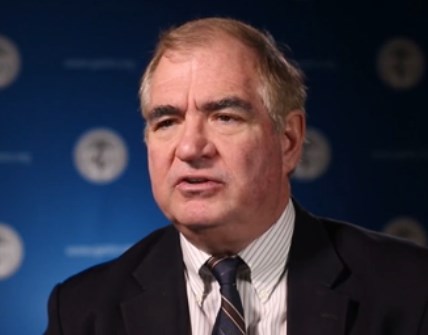User login
VIDEO: The future of personalized medicine in GI is in the hands of GI physicians
BOSTON – Personalized medicine is being used the most in oncology for diagnosis and it is showing us, for example, that there is not one type of leukemia but about 40, said Mara Aspinall, keynote speaker and executive chairman of GenePeeks. Gastroenterology is just beginning to use personalized medicine by using metabolites of gut microbiota and patient biomarkers to subtype disease and aid treatment. The nature of this kind of medicine is data driven and requires gastroenterologists to work together to accumulate data to analyze on a large scale, said Ms. Aspinall at the AGA Tech Summit, sponsored by the AGA Center for GI Innovation and Technology.
The video associated with this article is no longer available on this site. Please view all of our videos on the MDedge YouTube channel
BOSTON – Personalized medicine is being used the most in oncology for diagnosis and it is showing us, for example, that there is not one type of leukemia but about 40, said Mara Aspinall, keynote speaker and executive chairman of GenePeeks. Gastroenterology is just beginning to use personalized medicine by using metabolites of gut microbiota and patient biomarkers to subtype disease and aid treatment. The nature of this kind of medicine is data driven and requires gastroenterologists to work together to accumulate data to analyze on a large scale, said Ms. Aspinall at the AGA Tech Summit, sponsored by the AGA Center for GI Innovation and Technology.
The video associated with this article is no longer available on this site. Please view all of our videos on the MDedge YouTube channel
BOSTON – Personalized medicine is being used the most in oncology for diagnosis and it is showing us, for example, that there is not one type of leukemia but about 40, said Mara Aspinall, keynote speaker and executive chairman of GenePeeks. Gastroenterology is just beginning to use personalized medicine by using metabolites of gut microbiota and patient biomarkers to subtype disease and aid treatment. The nature of this kind of medicine is data driven and requires gastroenterologists to work together to accumulate data to analyze on a large scale, said Ms. Aspinall at the AGA Tech Summit, sponsored by the AGA Center for GI Innovation and Technology.
The video associated with this article is no longer available on this site. Please view all of our videos on the MDedge YouTube channel
2016 AGA TECH SUMMIT
VIDEO: How to make a value proposition for your device
Dr. Thomas Shehab, speaking at the 2016 AGA Tech Summit, which is sponsored by the AGA Center for GI Innovation and Technology, said that if he had one tip to offer a company working on a value proposition for their medical device, it would be to put it in the context of this dramatic time of change in health care. It doesn’t matter what the device is. It has to address changing realities in payment. The AGA Center for GI Innovation and Technology is a unique resource for innovators, he said, because it brings together groups that wouldn’t otherwise meet, like CEOs of startups, doctors, government stakeholders, and business interests such as his venture capital firm Arboretum Ventures.
The video associated with this article is no longer available on this site. Please view all of our videos on the MDedge YouTube channel
Dr. Thomas Shehab, speaking at the 2016 AGA Tech Summit, which is sponsored by the AGA Center for GI Innovation and Technology, said that if he had one tip to offer a company working on a value proposition for their medical device, it would be to put it in the context of this dramatic time of change in health care. It doesn’t matter what the device is. It has to address changing realities in payment. The AGA Center for GI Innovation and Technology is a unique resource for innovators, he said, because it brings together groups that wouldn’t otherwise meet, like CEOs of startups, doctors, government stakeholders, and business interests such as his venture capital firm Arboretum Ventures.
The video associated with this article is no longer available on this site. Please view all of our videos on the MDedge YouTube channel
Dr. Thomas Shehab, speaking at the 2016 AGA Tech Summit, which is sponsored by the AGA Center for GI Innovation and Technology, said that if he had one tip to offer a company working on a value proposition for their medical device, it would be to put it in the context of this dramatic time of change in health care. It doesn’t matter what the device is. It has to address changing realities in payment. The AGA Center for GI Innovation and Technology is a unique resource for innovators, he said, because it brings together groups that wouldn’t otherwise meet, like CEOs of startups, doctors, government stakeholders, and business interests such as his venture capital firm Arboretum Ventures.
The video associated with this article is no longer available on this site. Please view all of our videos on the MDedge YouTube channel
EXPERT ANALYSIS FROM THE AGA 2016 TECH SUMMIT
VIDEO: What really goes into getting new technologies paid for?
BOSTON – The real challenge for a new technology is not the good idea. It comes after FDA approval when a company must figure out how to get its device or procedure paid for, said Dr. Steven Schwaitzberg, professor and chief of the department of surgery at the University of Buffalo, speaking at the AGA Tech Summit, sponsored by the AGA Center for GI Innovation and Technology. Physicians want to provide cutting-edge tools to their patients, but they need to be reimbursed, and getting payers, like hospitals or government payers, to pay for the new procedure or device is the challenge. The AGA center facilitates this process by running observational research device registries to collect the data that show patient need, document value, and provide proof of efficacy.
The video associated with this article is no longer available on this site. Please view all of our videos on the MDedge YouTube channel
BOSTON – The real challenge for a new technology is not the good idea. It comes after FDA approval when a company must figure out how to get its device or procedure paid for, said Dr. Steven Schwaitzberg, professor and chief of the department of surgery at the University of Buffalo, speaking at the AGA Tech Summit, sponsored by the AGA Center for GI Innovation and Technology. Physicians want to provide cutting-edge tools to their patients, but they need to be reimbursed, and getting payers, like hospitals or government payers, to pay for the new procedure or device is the challenge. The AGA center facilitates this process by running observational research device registries to collect the data that show patient need, document value, and provide proof of efficacy.
The video associated with this article is no longer available on this site. Please view all of our videos on the MDedge YouTube channel
BOSTON – The real challenge for a new technology is not the good idea. It comes after FDA approval when a company must figure out how to get its device or procedure paid for, said Dr. Steven Schwaitzberg, professor and chief of the department of surgery at the University of Buffalo, speaking at the AGA Tech Summit, sponsored by the AGA Center for GI Innovation and Technology. Physicians want to provide cutting-edge tools to their patients, but they need to be reimbursed, and getting payers, like hospitals or government payers, to pay for the new procedure or device is the challenge. The AGA center facilitates this process by running observational research device registries to collect the data that show patient need, document value, and provide proof of efficacy.
The video associated with this article is no longer available on this site. Please view all of our videos on the MDedge YouTube channel
2016 AGA TECH SUMMIT
VIDEO: Dr. Tim Wang’s AGA Institute presidency will focus on innovation
BOSTON – Innovation, incoming AGA Institute President Timothy Wang explained at the AGA Tech Summit, is how AGA members will improve patient care and move the specialty forward. The AGA supports innovation through the work of the Center for GI Innovation and Technology, which sponsored the 2016 AGA Tech Summit, and by providing grants to young researchers through the AGA Research Foundation, such as the AGA–Boston Scientific and AGA–Covidien innovation awards, as well as many others.
The video associated with this article is no longer available on this site. Please view all of our videos on the MDedge YouTube channel
BOSTON – Innovation, incoming AGA Institute President Timothy Wang explained at the AGA Tech Summit, is how AGA members will improve patient care and move the specialty forward. The AGA supports innovation through the work of the Center for GI Innovation and Technology, which sponsored the 2016 AGA Tech Summit, and by providing grants to young researchers through the AGA Research Foundation, such as the AGA–Boston Scientific and AGA–Covidien innovation awards, as well as many others.
The video associated with this article is no longer available on this site. Please view all of our videos on the MDedge YouTube channel
BOSTON – Innovation, incoming AGA Institute President Timothy Wang explained at the AGA Tech Summit, is how AGA members will improve patient care and move the specialty forward. The AGA supports innovation through the work of the Center for GI Innovation and Technology, which sponsored the 2016 AGA Tech Summit, and by providing grants to young researchers through the AGA Research Foundation, such as the AGA–Boston Scientific and AGA–Covidien innovation awards, as well as many others.
The video associated with this article is no longer available on this site. Please view all of our videos on the MDedge YouTube channel
AT THE AGA 2016 TECH SUMMIT
Manufacturer issues new reprocessing instructions for ED-3490TK video duodenoscope
PENTAX, the manufacturer of the ED-3490TK video duodenoscope, has issued updated validated manual reprocessing instructions to replace those provided in the original device labeling in response to a Food and Drug Administration Safety Communication released last February concerning the design of endoscopic retrograde cholangiopancreatography (ERCP) duodenoscopes and the risk of multidrug-resistant bacterial infections.
The FDA has reviewed these updated reprocessing instructions and recommends that staff be trained to implement them as soon as possible. Several changes have been made to the protocol for precleaning, manual cleaning, and high-level disinfection that the FDA found to be adequate.
Olympus, the manufacturer of the TJF-Q180V duodenoscope has also issued updated manual reprocessing instructions.
In February 2015, the FDA first announced that the agency had received reports of multidrug-resistant bacterial infections in patients who had undergone ERCP with duodenoscopes that had been cleaned and disinfected properly (according to manufacturer instructions) and determined that the “complex design of ERCP endoscopes (also called duodenoscopes) may impede effective reprocessing.”
Since then, the FDA has been working with duodenoscope manufacturers to revise their manual reprocessing instructions to devise standard procedures to eliminate the risk of spreading infection between patients and better survey any contamination of the duodenoscopes.
The American Gastroenterological Association's Center for GI Innovation and Technology has been working closely with the FDA and device manufacturers to develop a path forward with zero device-associated infections.
Adverse events associated with duodenoscopes should be reported to the FDA’s MedWatch program at 800-332-1088 or www.accessdata.fda.gov/scripts/medwatch.
PENTAX, the manufacturer of the ED-3490TK video duodenoscope, has issued updated validated manual reprocessing instructions to replace those provided in the original device labeling in response to a Food and Drug Administration Safety Communication released last February concerning the design of endoscopic retrograde cholangiopancreatography (ERCP) duodenoscopes and the risk of multidrug-resistant bacterial infections.
The FDA has reviewed these updated reprocessing instructions and recommends that staff be trained to implement them as soon as possible. Several changes have been made to the protocol for precleaning, manual cleaning, and high-level disinfection that the FDA found to be adequate.
Olympus, the manufacturer of the TJF-Q180V duodenoscope has also issued updated manual reprocessing instructions.
In February 2015, the FDA first announced that the agency had received reports of multidrug-resistant bacterial infections in patients who had undergone ERCP with duodenoscopes that had been cleaned and disinfected properly (according to manufacturer instructions) and determined that the “complex design of ERCP endoscopes (also called duodenoscopes) may impede effective reprocessing.”
Since then, the FDA has been working with duodenoscope manufacturers to revise their manual reprocessing instructions to devise standard procedures to eliminate the risk of spreading infection between patients and better survey any contamination of the duodenoscopes.
The American Gastroenterological Association's Center for GI Innovation and Technology has been working closely with the FDA and device manufacturers to develop a path forward with zero device-associated infections.
Adverse events associated with duodenoscopes should be reported to the FDA’s MedWatch program at 800-332-1088 or www.accessdata.fda.gov/scripts/medwatch.
PENTAX, the manufacturer of the ED-3490TK video duodenoscope, has issued updated validated manual reprocessing instructions to replace those provided in the original device labeling in response to a Food and Drug Administration Safety Communication released last February concerning the design of endoscopic retrograde cholangiopancreatography (ERCP) duodenoscopes and the risk of multidrug-resistant bacterial infections.
The FDA has reviewed these updated reprocessing instructions and recommends that staff be trained to implement them as soon as possible. Several changes have been made to the protocol for precleaning, manual cleaning, and high-level disinfection that the FDA found to be adequate.
Olympus, the manufacturer of the TJF-Q180V duodenoscope has also issued updated manual reprocessing instructions.
In February 2015, the FDA first announced that the agency had received reports of multidrug-resistant bacterial infections in patients who had undergone ERCP with duodenoscopes that had been cleaned and disinfected properly (according to manufacturer instructions) and determined that the “complex design of ERCP endoscopes (also called duodenoscopes) may impede effective reprocessing.”
Since then, the FDA has been working with duodenoscope manufacturers to revise their manual reprocessing instructions to devise standard procedures to eliminate the risk of spreading infection between patients and better survey any contamination of the duodenoscopes.
The American Gastroenterological Association's Center for GI Innovation and Technology has been working closely with the FDA and device manufacturers to develop a path forward with zero device-associated infections.
Adverse events associated with duodenoscopes should be reported to the FDA’s MedWatch program at 800-332-1088 or www.accessdata.fda.gov/scripts/medwatch.
Angiogenic kinase inhibitor receives orphan drug designation for hepatocellular carcinoma
ENMD-2076, an oral Aurora A/angiogenic kinase inhibitor has received an orphan drug designation from the Food and Drug Administration to treat hepatocellular carcinoma, according to a statement issued by the manufacturer on July 7. With that status, maker CASI Pharmaceuticals will be able to market the drug exclusively for 7 years, solicit additional funding for research, and receive clinical protocol assistance.
"The Orphan Drug designation ... confirms our belief in the versatility of ENMD-2076 as a promising treatment for HCC, and for other tumor types that we are currently evaluating in the clinic," Dr. Ken Ren, chief executive officer of CASI, said in the statement. "We are finalizing our next steps for ENMD-2076 in HCC and/or in fibrolamellar carcinoma, a subset of HCC for which there is no treatment available."
ENMD-2076 has multiple mechanisms of action and has been shown to inhibit distinct angiogenic tyrosine kinase targets in addition to the Aurora A kinase. The Aurora kinases are regulators of cell division that are often over-expressed in human cancers. The drug also targets other kinases, VEGFR, Flt-3, and FGFR3, which play roles in several cancers. ENMD-2076 showed positive activity in phase I clinical trials in solid tumor cancers such as ovarian, breast, liver, renal, and sarcoma; activity was also shown in leukemia and multiple myeloma.
ENMD-2076 has already received orphan drug designation from the FDA for the treatment of ovarian cancer, multiple myeloma, and acute myeloid myeloma.
ENMD-2076, an oral Aurora A/angiogenic kinase inhibitor has received an orphan drug designation from the Food and Drug Administration to treat hepatocellular carcinoma, according to a statement issued by the manufacturer on July 7. With that status, maker CASI Pharmaceuticals will be able to market the drug exclusively for 7 years, solicit additional funding for research, and receive clinical protocol assistance.
"The Orphan Drug designation ... confirms our belief in the versatility of ENMD-2076 as a promising treatment for HCC, and for other tumor types that we are currently evaluating in the clinic," Dr. Ken Ren, chief executive officer of CASI, said in the statement. "We are finalizing our next steps for ENMD-2076 in HCC and/or in fibrolamellar carcinoma, a subset of HCC for which there is no treatment available."
ENMD-2076 has multiple mechanisms of action and has been shown to inhibit distinct angiogenic tyrosine kinase targets in addition to the Aurora A kinase. The Aurora kinases are regulators of cell division that are often over-expressed in human cancers. The drug also targets other kinases, VEGFR, Flt-3, and FGFR3, which play roles in several cancers. ENMD-2076 showed positive activity in phase I clinical trials in solid tumor cancers such as ovarian, breast, liver, renal, and sarcoma; activity was also shown in leukemia and multiple myeloma.
ENMD-2076 has already received orphan drug designation from the FDA for the treatment of ovarian cancer, multiple myeloma, and acute myeloid myeloma.
ENMD-2076, an oral Aurora A/angiogenic kinase inhibitor has received an orphan drug designation from the Food and Drug Administration to treat hepatocellular carcinoma, according to a statement issued by the manufacturer on July 7. With that status, maker CASI Pharmaceuticals will be able to market the drug exclusively for 7 years, solicit additional funding for research, and receive clinical protocol assistance.
"The Orphan Drug designation ... confirms our belief in the versatility of ENMD-2076 as a promising treatment for HCC, and for other tumor types that we are currently evaluating in the clinic," Dr. Ken Ren, chief executive officer of CASI, said in the statement. "We are finalizing our next steps for ENMD-2076 in HCC and/or in fibrolamellar carcinoma, a subset of HCC for which there is no treatment available."
ENMD-2076 has multiple mechanisms of action and has been shown to inhibit distinct angiogenic tyrosine kinase targets in addition to the Aurora A kinase. The Aurora kinases are regulators of cell division that are often over-expressed in human cancers. The drug also targets other kinases, VEGFR, Flt-3, and FGFR3, which play roles in several cancers. ENMD-2076 showed positive activity in phase I clinical trials in solid tumor cancers such as ovarian, breast, liver, renal, and sarcoma; activity was also shown in leukemia and multiple myeloma.
ENMD-2076 has already received orphan drug designation from the FDA for the treatment of ovarian cancer, multiple myeloma, and acute myeloid myeloma.



